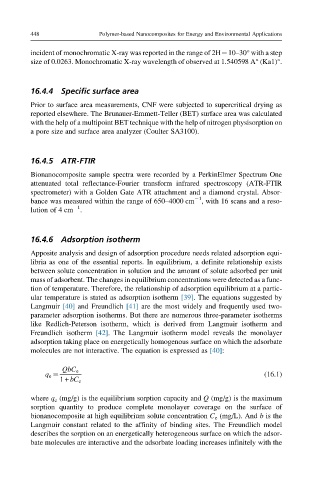Page 495 - Polymer-based Nanocomposites for Energy and Environmental Applications
P. 495
448 Polymer-based Nanocomposites for Energy and Environmental Applications
incident of monochromatic X-ray was reported in the range of 2H¼10–30° with a step
size of 0.0263. Monochromatic X-ray wavelength of observed at 1.540598 A° (Ka1)°.
16.4.4 Specific surface area
Prior to surface area measurements, CNF were subjected to supercritical drying as
reported elsewhere. The Brunauer-Emmett-Teller (BET) surface area was calculated
with the help of a multipoint BET technique with the help of nitrogen physisorption on
a pore size and surface area analyzer (Coulter SA3100).
16.4.5 ATR-FTIR
Bionanocomposite sample spectra were recorded by a PerkinElmer Spectrum One
attenuated total reflectance-Fourier transform infrared spectroscopy (ATR-FTIR
spectrometer) with a Golden Gate ATR attachment and a diamond crystal. Absor-
1
bance was measured within the range of 650–4000 cm , with 16 scans and a reso-
1
lution of 4 cm .
16.4.6 Adsorption isotherm
Apposite analysis and design of adsorption procedure needs related adsorption equi-
libria as one of the essential reports. In equilibrium, a definite relationship exists
between solute concentration in solution and the amount of solute adsorbed per unit
mass of adsorbent. The changes in equilibrium concentrations were detected as a func-
tion of temperature. Therefore, the relationship of adsorption equilibrium at a partic-
ular temperature is stated as adsorption isotherm [39]. The equations suggested by
Langmuir [40] and Freundlich [41] are the most widely and frequently used two-
parameter adsorption isotherms. But there are numerous three-parameter isotherms
like Redlich-Peterson isotherm, which is derived from Langmuir isotherm and
Freundlich isotherm [42]. The Langmuir isotherm model reveals the monolayer
adsorption taking place on energetically homogenous surface on which the adsorbate
molecules are not interactive. The equation is expressed as [40]:
QbC e
q e ¼ (16.1)
1+ bC e
where q e (mg/g) is the equilibrium sorption capacity and Q (mg/g) is the maximum
sorption quantity to produce complete monolayer coverage on the surface of
bionanocomposite at high equilibrium solute concentration C e (mg/L). And b is the
Langmuir constant related to the affinity of binding sites. The Freundlich model
describes the sorption on an energetically heterogeneous surface on which the adsor-
bate molecules are interactive and the adsorbate loading increases infinitely with the

